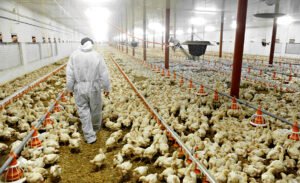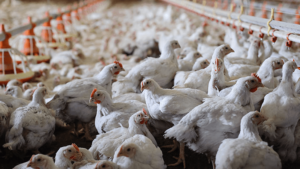Live infectious bronchitis IB vaccines and the persistence of the disease in Iraqi poultry
Baghdad 24/6/2024
Professor Dr. Salah Mahdi Hassan / Specialist and consultant in poultry diseases and health

From my field observations during my work in the poultry sector, and for a long time, regarding the use of live vaccines for the so-called Infectious Bronchitis (IB) disease in poultry fields, it is a harmful process for chickens, through comparison between vaccinated flocks and unvaccinated flocks, whether layers or broilers.
I had practiced it through my health responsibility on Fawbro’s asset poultry within the research station for asset poultry in Rashidiya research center, in the city of Mosul for more than 13 years, noting that the first stage in establishing the assets was sending me vaccines from Baghdad, including a live IB vaccine for two strains: H120 and H52, I noticed the difference between batches that were vaccinated and others that were not vaccinated, by me.
The results of unvaccinated poultry were better, healthier and more productive. Accordingly, I decided and informed the administration that I would not use the IB vaccine at the previously mentioned station, and my request was granted. In addition to being informed of disease cases of broilers that were diagnosed by my dear colleagues as IB, they were cases of E. Coli disease, and that was the result of stress and failure to apply biosecurity or a defect in ventilation, which is the major issue in the failure of the broiler industry in Iraq.

Later, I followed the same context by not using the live IB vaccine when I was assigned to manage the mother poultry project in the Shallalat poultry farm of Al-Amin Company for Agricultural and Animal Production in Nineveh Governorate. The results were impressive, and we were not exposed to any disease problem during my two-year presence in the project.
I also followed the same context in the Taq Taq poultry project of the Kosar Agricultural and Animal Production Company in Erbil, in the year 2004, and throughout my time in charge of veterinary health for the project until the year 2017, we did not use live IB vaccines.
In the year 2008, there was a wave of deaths in flocks of laying hens, mothers, and broilers, reaching up to 60% in some projects, and the accusation was directed at IB disease. However, I had another opinion, and it centered between the Newcastle infections and the avian influenza virus (H9N2), noting that poultry projects in the Kurdistan region and Iraq have and still use the H9N2 vaccine???
It happened that at the same time I was a (visiting) professor at the College of Veterinary Medicine/University of Dohuk. A student applied to study for a doctorate in poultry diseases, and she is my dear colleague, the late Dr. (Awat Arif Al-Naqshbandi), may God have mercy on her. I agreed with her to make visits to the poultry fields in Kurdistan Region, which suffer from high mortality, to collect pathological samples, so that we can perform microbial isolation which we do within the Kurdistan Region. We send the viral isolate to the Wiberg Reference Laboratory in Britain, and after I agreed with one of the researchers in the same laboratory, whom I met at a scientific conference on influenza in 2006 in Cambridge/United Kingdom, her name is (Wendy Shell), the required examination was about the Newcastle, influenza, and IB viruses. Exclusively, the pathological samples were sent using the correct scientific methods and via FedEx mail, and the samples represented (31 poultry fields or projects in Erbil and Sulaymaniyah). The results were returned as follows, documented in official books from the laboratory concerned and available in the body of the doctoral thesis at the College of Veterinary Medicine/University of Dohuk:
Only two out of 32 fields from which the Newcastle virus was isolated, and 11 fields out of 31 fields from which the H9N2 influenza virus was isolated, and only two fields out of 31 fields from which the Newcastle virus and H9N2 were isolated, and the IB virus was not isolated from all 31 samples sent.
As for the bacterial isolation of the 31 project or field samples, it showed a heavy presence of negative bacteria belonging to the Enterobacteriacea family, to which E. coli belongs.
The other note; It is a scientific research work in the year 2012 by one of master’s students at the College of Veterinary Medicine / University of Mosul. He is my dear colleague Dr. (Abdul Jabbar Muhammad Hussein Al-Jubouri), who is currently a professor at the College of Veterinary Medicine / Tikrit University. The idea of the research resulted from my observations about poultry. Those vaccinated with live IB vaccines, and after vaccination, suffer from an obstruction in the health status of the herd, and therefore the idea of the research was to study the IB vaccines available in the Iraqi market from the pathological and immunological aspects and their interaction with the immunity of the Newcastle vaccine, which is important for poultry.
(( A study on the effects of infectious bronchitis live vaccines (H120, Ma5 and 4/91) on the health status and the immunological response of the vaccinated broilers)).
The results showed and were painful in terms of the damage and harm that live vaccines cause to vaccinated chickens in terms of their destruction of the layer of cilia that surrounds the trachea, in addition to severe kidney injuries, especially for the vaccine (4/91). There are pictures of the tissues that anyone interested can view.
When I was referring to the harm resulting from IB vaccines in vaccinated chickens, as well as the devastating effect of introducing highly virulent vaccine strains of the IB virus, we were accused by the company supplying the vaccine of being hostile to our company and they put us on a blacklist in dealing!
I had a friend who was a poultry farmer. He was great in his experience and morals, and he is my friend on Facebook, and I firmly believe that he will read this post. He had a flock of mothers at the beginning of production, with all signs of sexual maturity and signs of laying hens, but the flock’s production was very small! When he summoned me, the result was the complete absence of the oviduct and the ovaries were fully developed, a condition called (false layer) and it is one of the signs of infection with the IB virus in the initial stages of life. When asked about the history of the case, it was revealed that the vaccine (4/91) was used.
Today, the Iraqi field is full of live vaccines and types of IB viruses that have not been monitored in the field by the governmental veterinary authorities, which are responsible for animal health according to the Animal Health Law. Therefore, the eternal opinion was that live vaccines for IB disease are the basis for the continuation of the problem of infectious bronchitis. IB causes economic losses to the poultry industry sector in Iraq.
What is strange is that the daily news from Iraqi university researchers tells us every day that someone has won by registering a strain for IB disease and depositing it in the gene bank??? . In fact, it remains not scientifically approved because it was not accompanied by viral isolation of the samples for which molecular testing was performed, because the environment is full of vaccine viruses, not to mention field viruses that interact with vaccine viruses to produce new viruses whose harmful effects on the health of poultry are unknown.

Now what has awakened this topic in my mind is my exposure to a recent study published in an international journal considered the most important journal in the field of poultry diseases (Avian Disease)
https://doi.org/10.1637/aviandiseases-D-23-00064 by American researchers who point out an important fact, which is the dangerous role played by live vaccines for IB in the continued occurrence of the disease and its significant losses in Poultry industry, through the interconnection of field virus genes with vaccine viruses, especially the S1 sequencing of those viruses, resulting in hybrid viruses to which current vaccines cannot provide immunity due to their penetration of antibodies, escape immunity, or the ability of modern viruses to cause greater harm to chickens vaccinated with current vaccines.
Therefore, the study called for the manufacture of vaccines using new technologies, such as recombinants vaccines, subunit vaccines, vector vaccines, or nucleic acid-base vaccines, which work to provide safer and more effective immunization alternatives to protect poultry from infectious diseases.
Title of the American study: (Protection Against Infectious Bronchitis Virus Vaccine Recombinants and Chicken-Selected Vaccine Subpopulations), Publishing: Avian Diseases, 68(2):89-98 (2024).



